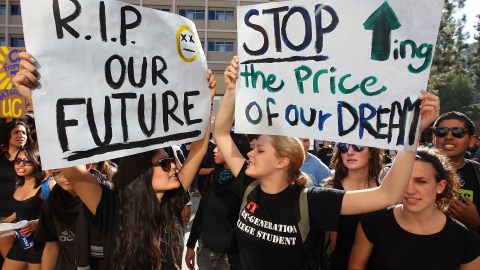Predatory loans and the schools that get poor students to take them

David McNew/Getty Images
- Student debt is a major issue facing Americans.
- The problem is made worse when factoring the large number of predatory schools that exist.
- Students that go to these schools often take out massive loans but get little out of it.
There is a student loan crisis in the United States. The massive amount of debt held by students is now the second leading cause of indebtedness in the country. The effect of this debt on the economy at large, as well as on the people who hold it, has been widely discussed and is overwhelmingly negative.
However, the vastness of the problem often obscures the multitude of elements that comprise it. Today we hope to help fix that by shining a light on predatory student loans and the damage they cause.
Predatory student loans, how can you even have such a thing?
In this country, a college education is often viewed as an investment. You borrow a lot of money for it but know going in that you’re likely to get a good job after you leave that will allow you to pay the loans back. Many colleges and universities know how popular that line of thinking is and point out in their advertisements how many students get good jobs after graduation.
However, some organizations play fast and loose with those numbers to make a buck. As the Harvard Project on Predatory Student Lending explains, many shady for-profit colleges promise incredible job placement rates for graduates despite not being able to deliver. Such unscrupulous schools also tend to spend more on advertising than they do on actually teaching, the average one uses about a quarter of their profits for education.
As a result, there are plenty of schools that hand out practically worthless degrees. Many students who attended schools owned by Corinthian, a now-defunct company, have asserted that the educational program was dismal. One Medical Assistant student explained how students were expected to practice medical procedures on one another rather than on patients in a clinical setting. The resultant accident could only be expected.
The ones with useless degrees might consider themselves lucky, the dropout rates at schools like this are often rather high, leaving the students with nothing but debt.
Students targeted by these schemes also tend to be groups that need a college education the most, such as the poor, racial minorities, veterans, and first-generation college students. Since student loans made to veterans don’t count against the limiting number of federal loans a private school can have, many colleges have been accused of trying to enroll veterans who aren’t fully able to attend or master classes as another way to make a quick buck.
In another notable case at Everest College, a librarian at one school resigned in protest after realizing that one student they were helping read at a third-grade level and was unlikely to either graduate or work in their intended field. Other schools which have drawn ire for either letting in students who they shouldn’t, shady practices, or low standards include Ashford University and Kaplan.
There are other methods of gaming the student loan system for profit other than running a whole school, of course. Private lenders offering loans at higher rates than the federal government without nearly so many programs for forgiveness or graduated repayment exist and make a killing on the backs of hardworking students. In some cases, major companies made loans that no sane banker would ever make — allegedly, purposely trapping students in debt.
Why do such things exist at all?
In a word, money.
While for-profit education has always existed in the United States in some form or another, there has been a spike in the number of such schools over the past two decades as a result of changes in how the federal government interacts with them. So long as a few guidelines are kept to about how much of their income is directly coming from federal student loans, these schools can rake in federal student loan money. It is a very useful system for making tons of cash.
How do these loans relate to other issues facing college grads today?
Remember how a college education was supposed to be a one-way ticket to a well-paying job that would make an “investment” in your education something that was totally sound? Yeah, that hasn’t quite worked out for a lot of people just yet. The new shape of the economy is making alternative educational models look attractive.
While a college degree is still “worth it” from a financial standpoint, millennials are making less now than their parents and grandparents were making at the same age and own fewer assets as a result of it. Pair that with the trillion dollars’ worth of student debt they took on to make less money and you understand why young people aren’t going to be able to retire until they’re 70.
The people who hold loans they took out to finance their time at sham schools are therefore in even worse shape, since they endure all the hardships of crippling student debt but often without the actual degree, a degree of any quality, or any ability to get the job they trained for.
The question of how to finance the university level education of American students hasn’t adequately been answered. Until we devise a better system, unscrupulous people will continue to find ways to scam those who just want to improve their lives — and profit off of them.





